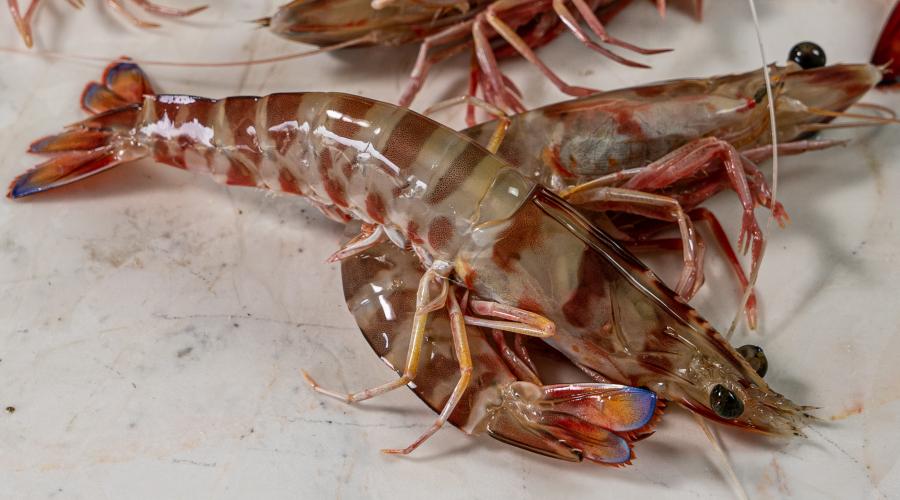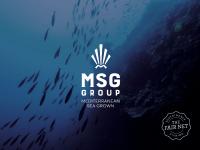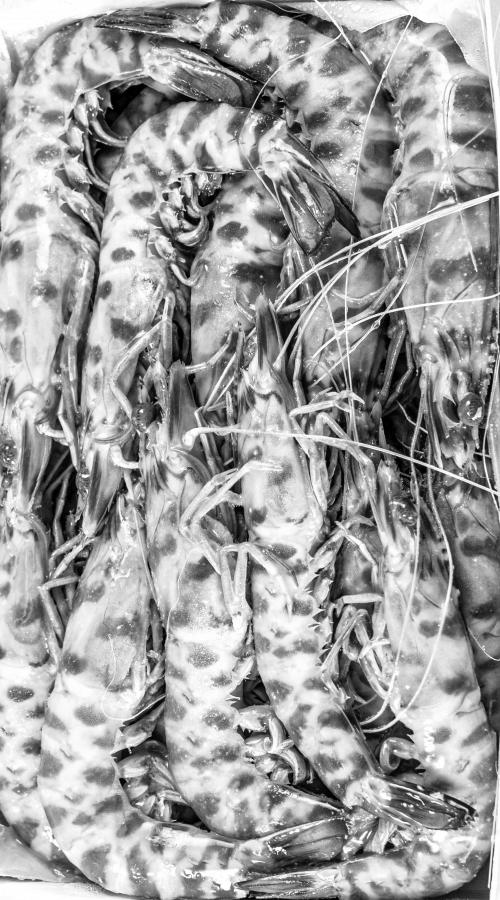
Caramote shrimp (Langostino)
Code Name : TGS
Scientific Name : Melicertus (Penaeus) kerathurus
Caramote shrimp (Langostino) classification: Arthropoda (phylum), Crustacea (subphylum) and Panaeidae (family).
This species is known by the scientific names Penaeus sulcatus and Penaeus caramota. Common names used locally to refer to this shrimp are: caramote (France), langostino (Spain), mazzancolla (Italy), caramote (England), gombri and shrimp (Tunisia). In the hierarchy it belongs in the super-class Crustacea.
This is a large shrimp exceeding 22 cm in total length it has a beige coloured exoskeleton with dark transverse bands forming separate spots on the side of the body and with blue uropodes.
Melicertus kerathurus has a wide geographical distribution in the world. It is found throughout the Mediterranean basin (including the Marmara Sea) and in the eastern Atlantic from Portugal to Angola. In the northeastern Atlantic it has been occasionally reported in the south of England. In Tunisia this species is especially abundant in the Gulf of Gabès, which has been known for a long time.
M. kerathurus is a demersal species living in coastal areas, in water with high salinity and in very shallow waters at the shore or in brackish water on sandy or sandy mud bottoms in pits of debris and on clean seabeds with sand and seagrass. It can be found at depths of 0.5 to 100 m but it is common between 5 and 40 m. Although the caramota is considered to be present at all depths, the best catches are recorded at shallow depths reflecting the coastal nature of this species. In addition, the abundance of this species appears to decrease with depth. Exceptionally, in the Strait of Sicily, the species has been recorded at maximum depths of 640 m.
Very small juveniles lead a sedentary life near the shores at very shallow depths. At 5 to 8 cm juveniles begin migrating to a depth of about 50 meters where they await the spring season to reach the spawning grounds.
The caramote performs two types of migration: one trophic vertical and one genetic, horizontal migration. During the day it reacts to the solar irradiance with a negative phototropism and goes towards the bottom, sinking completely into the sand or mud, hiding among the vegetation such as algae, Posidonia or plant debris. On the contrary, at night the shrimp temporarily leaves this area to swim and make incursions into neighboring areas to feed.
In relation to bathimetric distribution during the horizontal migration the young fraction of the population stays strictly within the coastal area while the largest prawns occupy the deepest areas, below 25 m. Most catches are based on the oldest fraction of the population. Larger individuals are more abundant over 40 m depth.
M. kerathurus is a large shrimp: the total length is usually 11-14 cm for males and 13-17 cm for females. The maximum size were observed at 2011 in Greece and in Italy respectively, of 25.2 and 27.2 cm total length.
Spawning begins from June to July and lasts until late September, early October, while older females are more precocious. It is important to note that a similar pattern of seasonal reproduction (April-September) has been observed in Greece in the Ionian Sea (May to September), in the Aegean Sea (May to October) and in Sicily.
The life cycle of caramota lasts about three years. This species is characterised by rapid growth and a relatively high rate of natural mortality. Studies in Italy and Greece indicate longevity between 2 and 3 + years.
Adult M. kerathurus follow a diet consisting mainly of molluscs, crustaceans and polychaetes, while Juveniles feed mainly on crustaceans.
The species is caught in out nets throughout the year, in quantities and sizes that vary depending on the fishing area, the fishing depth and the time of the year. The product is available in two conditions: fresh and as an Aegean Harvest brand (frozen-on-board).

- Νο 1 : 10 ~ 15 pcs / kg
- No 2 : 25 ~ 35 pcs / kg
FRESH CATCH with ICE FLAKES
- 2 kg (polystyrene box)
- 5 kg (polystyrene box)
AEGEAN HARVEST (FROZEN)
- 1 kg (iqf Pe/Pa bag)
- 2 kg (iqf Pe/Pa bag)
- 1½ kg (carton box)
- 2 kg (carton box)
- 2 kg (vacuum block)
- 4 kg (vacuum block)
- 5 kg (vacuum block)
FAO. 37 Mediterranean Sea
FAO. 37.3.1 North Aegean Sea
0 kg
-18 °C and below (in freezer)

